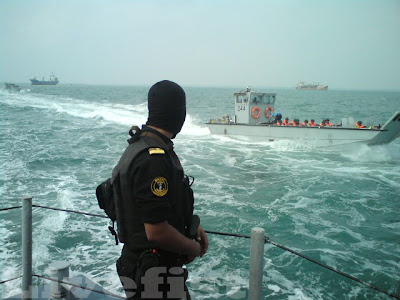10:51 GMT, November 26, 2010 defpro.com | The Indian Navy is still waiting for the delivery of the Russian-built aircraft carrier INS Vikramaditya (ex-Admiral Gorshkov), which has been scheduled for December 2012. As Indian Defence Minister Shri A.K. Antony recently informed the government, the delay of the delivery is, in particular, due to the "requirement of additional work and changes in the scope of trials." According to the Indian Press Information Bureau, the Minister explained that these additional refurbishments of the giant vessel would significantly increase its service life. The carrier is currently docked at the Russian Sevmash shipyard.
The Admiral Gorshkov aircraft carrier was launched in 1982 and entered service with the Russian Navy in 1987. In 2004, Russia agreed to sell the aircraft carrier, which required serious refurbishment and modernisation, to India. However, payment issues and unexpectedly intensive work requirements repeatedly forced Russia to delay the ship's delivery. Should the carrier finally join the Indian Navy in 2012, it will see active service after sixteen years of being moored in Russian ports and shipyards since it was offered for sale in 1996.
The procurement of the Admiral Gorshkov has certainly caused stomach aches to one or the other members of the Indian government, as costs have steadily increased throughout recent years. Originally, India agreed to purchase the ship at a price of $974 million. Subsequently, this amount increased by an additional $1.5 billion. However, the aged Admiral Gorshkov required more than a new layer of paint and a little smooth and polish. The money was quickly spent by the Russian shipyard, which underestimated the required amount of work. Further, according to Antony, the original contract was supplemented by "an exhaustive list of equipment to be fitted on the ship."
In March, on the occasion of an official visit of Russian Prime Minister Vladimir Putin to India, the two countries announced the signing of an agreement for an additional $2.35 billion in support of the carrier's refurbishment and training of Indian naval crews; these additional funds had already been approved by the Indian government months before the bilateral meeting. This adds up to a proud price tag for a vessel which has been criticised by some defence experts for being too expensive while not providing the state-of-the-art capabilities required by the Indian Navy in the current security-political environment (see also
http://goo.gl/vbRwz or
http://goo.gl/bQQt5).
As the Minister explained this summer, a team of Indian specialists, comprising officers, sailors and civilian personnel, have been sent to Russia to monitor the progress of the work onboard the ship. In June, the Indian Navy expressed delight at the Sevmash shipyard's progress. "The pace of the work has picked up significantly in the last six months. This can be attributed to the additional deployment of manpower for the refurbishment of the aircraft carrier," Indian Navy spokesperson Commander Satish told an Indian news service.
The Admiral Gorshkov, which has been re-christened the INS Vikramaditya by India, is a modified Kiev-class carrier. It reportedly has a displacement capacity of 45,000 tons, a maximum speed of 32 knots and a range of 13,500 nautical miles (25,000 kilometres) at a cruising speed of 18 knots. The ship will accommodate Russian-built MiG-29K fighter aircraft, which have already been purchased for some $526 million, along with the aircraft carrier in 2004. The aircraft are configured for Short Take Off But Arrested Landing (STOBAR), take-offs being supported by the ship's prominent ski-jump ramp. The first batch of MiG-29Ks was inducted into the Indian Navy earlier this year and will operate from the shore-based facility at INS Hansa in Goa until the aircraft carrier is delivered.
Despite the criticism, INS Vikramaditya will provide the Indian Navy with a significant platform to project military power to every corner of the world's oceans. The country, thereby, enters a currently very exclusive club of operators of aircraft carriers that do not rely on STOVL (Short Take Off, Vertical Landing) aircraft.
This week, the UK's last Harrier STOVL aircraft was launched from HMS Ark Royal and the country will not receive its new aircraft carrier, planned to accommodate F-35C joint strike fighters, in the near future. Furthermore, France repeatedly experiences technical difficulties with its carrier, the Charles de Gaulle. In addition to the operator of the world's largest fleet of aircraft carriers for conventional fighter aircraft, the United States, there only remains Brazil (NAe São Paulo) and Thailand (HTMS Chakri Naruebet).
Daniel Goure of the Lexington Institute recently said about the US carriers: "There is no more strategically agile, operationally responsive and tactically flexible platform [...] than the aircraft carrier" (see
http://goo.gl/V7uV9). Although India is far from reaching the United States' level of capabilities provided by its numerous aircraft carriers, the long waiting time for the INS Vikramaditya may eventually pay off from a security-political point of view. However, it remains questionable, if it was worth to spend this much money and if alternatives should have been seriously considered at an earlier point in time.












